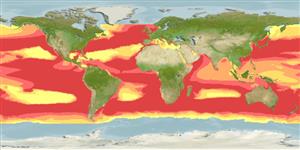分類 / Names
俗名 | 同種異名 | Catalog of Fishes(屬, 種) | ITIS | CoL | WoRMS | Cloffa
Elasmobranchii
板鰓亞綱 (鯊魚與魟魚) (sharks and rays) >
Lamniformes (Mackerel sharks) >
Lamnidae (Mackerel sharks or white shark)
Etymology: Carcharodon: carchar-, presumably referring to Carcharias (Odontaspidae); odon (Gr.), tooth, “Teeth as in Carchari[a]s, serrated on both edges”. (See ETYFish); carcharias: From the Ancient Greek karkharías, shark, derived from kárkharos, sharp or jagged, referring to its teeth (“dentibus serratus”). (See ETYFish).
More on author: Linnaeus.
Environment: milieu / climate zone / depth range / distribution range
生態學
海洋; 半鹹淡水; 海洋洄游的 (Ref. 51243); 深度上下限 0 - 1280 m (Ref. 106604), usually 0 - 250 m (Ref. 55270). ; 61°N - 58°S, 180°W - 180°E
Worldwide. Very wide-ranging in most oceans; among the greatest habitat and geographic range of any fish, tolerating temperatures of 5°-25°C.
Length at first maturity / 大小 / 重量 / 年齡
Maturity: Lm 475.0, range 450 - 500 cm
Max length : 640 cm TL 雄魚/尚未辨別雌雄; (Ref. 12489); 最大體重: 0.00 g; 最大年齡: 36 年 (Ref. 31395)
背棘 (總數) : 0; 臀棘: 0. A huge, spindle-shaped shark with conspicuous black eyes, a blunt, conical snout and large, triangular, saw-edged teeth (Ref. 5578). First dorsal-fin origin usually over the pectoral-fin inner margins (Ref. 43278, 6871). Caudal fin crescentic (Ref. 247). Lead-grey to brown or black above, lighter on sides, and abruptly white below (Ref. 6851). Black spot at rear pectoral fin base (Ref. 6851).
Primarily a coastal and offshore inhabitant of continental and insular shelves, but may also occur off oceanic islands far from land (Ref. 247, 43278, 58302). Often close inshore to the surf line and even penetrates shallow bays (Ref. 247). Maximum depth of 700 fathoms (or 1280 m) reported by Bigelow & Schroeder, 1948 is erroneous (Francis et al., 2012 in Ref. 106604). Pelagic, capable of migration across oceanic regions (Ref. 58302). Usually solitary or in pairs but can be found in feeding aggregations of 10 or more; does not form schools (Ref. 247). Feeds on bony fishes, sharks, rays, seals, dolphins and porpoises, sea birds, carrion, squid, octopi and crabs (Ref. 5578) and whales (Ref. 32140). Ovoviviparous, embryos feeding on yolk sac and other ova produced by the mother (Ref. 43278, 50449). Number of young born per litter, 7 (Ref. 31395) to 14 (Ref. 26346). Reported by some experts to attack humans which they mistake for their normal prey (Ref. 47). Most attacks occur in estuaries. Caught by big-game anglers and line boats for its jaws (Ref. 5578). Reported to cause poisoning (Ref. 4690). Flesh is utilized fresh, dried-salted, and smoked for human consumption, the skin for leather, liver for oil, carcass for fishmeal, fins for shark-fin soup, and teeth and jaws for decorations (Ref. 13574). Maximum total length is leading to much speculation and some measurements are found to be doubtful. Possibly to 6.4 m or more in length (Ref. 43278), considered the world's largest predator with a broad prey spectrum. The record of 10.98 m is incorrect (Ref. 13574). Maximum total length for male from Ref. 91029. Sometimes considered the most dangerous shark in the world (Ref. 26938). Maximum depth reported taken from Ref. 86942.
Exhibit ovoviparity (aplacental viviparity), with embryos feeding on other ova produced by the mother (oophagy) after the yolk sac is absorbed (Ref. 50449). Up to 10, possibly 14 young born at 120-150 cm (Ref. 26346). Distinct pairing with embrace (Ref. 205). Male and female may swim in parallel while copulating (Ref. 28042, 49562).
Compagno, L.J.V., 1984. FAO Species Catalogue. Vol. 4. Sharks of the world. An annotated and illustrated catalogue of shark species known to date. Part 1 - Hexanchiformes to Lamniformes. FAO Fish. Synop. 125(4/1):1-249. Rome, FAO. (Ref. 247)
人類使用
漁業: 低經濟; 游釣魚種: 是的
工具
特別的報告
下載 XML
網路資源
Estimates based on models
Preferred temperature (Ref.
123201): 11.3 - 24.9, mean 18.1 °C (based on 4368 cells).
Phylogenetic diversity index (Ref.
82804): PD
50 = 1.0313 [Uniqueness, from 0.5 = low to 2.0 = high].
Bayesian length-weight: a=0.00871 (0.00623 - 0.01217), b=3.05 (2.96 - 3.14), in cm total length, based on LWR estimates for this species (Ref.
93245).
營養階層 (Ref.
69278): 4.5 ±0.4 se; based on diet studies.
回復力 (Ref.
120179): 非常低的, 最小族群倍增時間超過14 年 (K=0.06; tm=8-12; tmax=36; Fec=7).
Fishing Vulnerability (Ref.
59153): Very high vulnerability (86 of 100).
Climate Vulnerability (Ref.
125649): High vulnerability (60 of 100).
